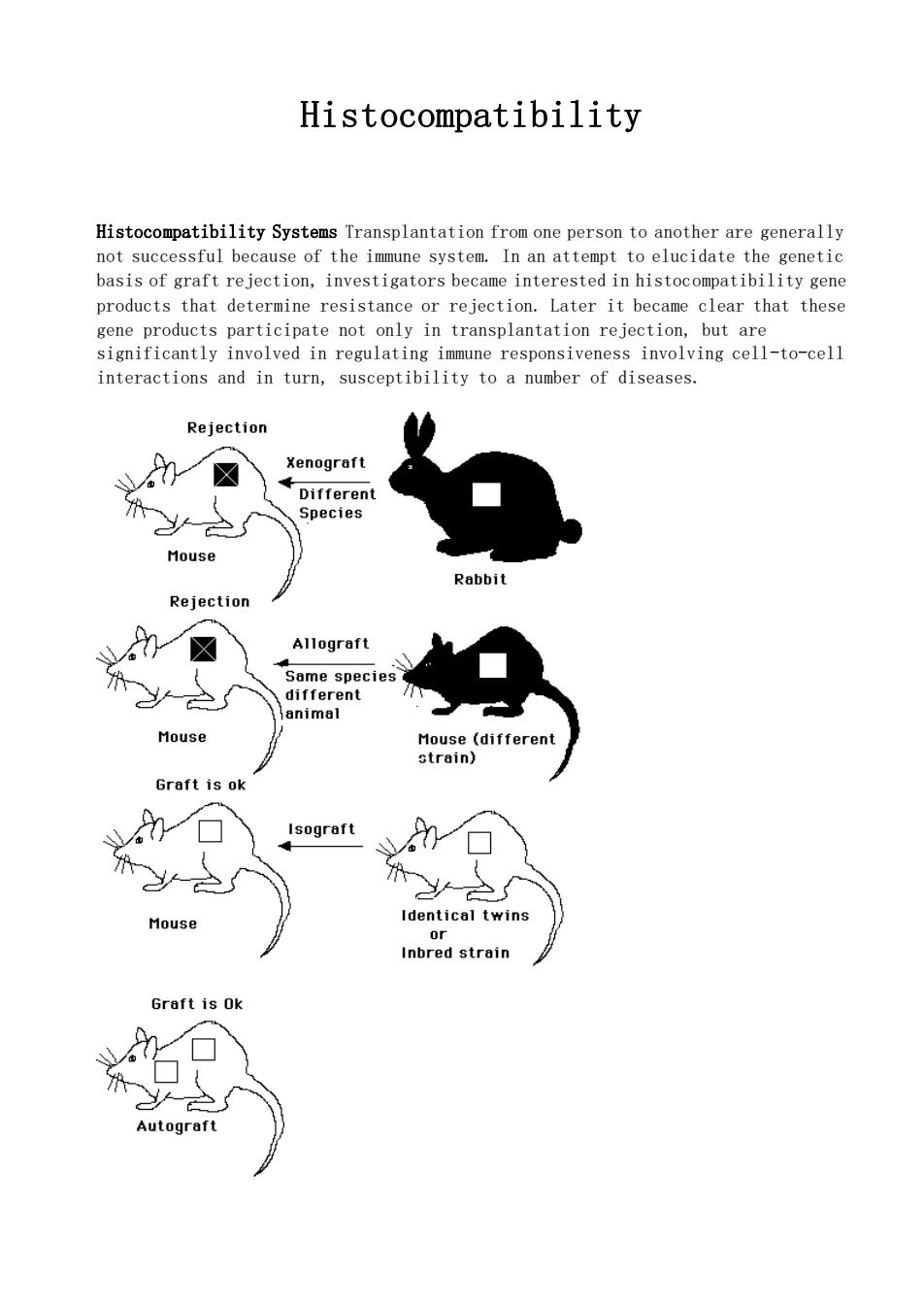
Histocompatibility Histocompatibility Systems Transplantation from one person to another are generally not successful because of the immune system.In an attempt to elucidate the genetic basis of graft rejection,investigators became interested in histocompatibility gene products that determine resistance or rejection.Later it became clear that these gene products participate not only in transplantation rejection,but are significantly involved in regulating immune responsiveness involving cell-to-cell interactions and in turn,susceptibility to a number of diseases. Rejection ☒ Xenogroft ifferent Species Mouse Rabbit Rejection ☒ Allograft Some species Mouse Graft is oh Isograft y人 Identical twins Inbred strain Graft is Ok
Histocompatibility Histocompatibility Systems Transplantation from one person to another are generally not successful because of the immune system. In an attempt to elucidate the genetic basis of graft rejection, investigators became interested in histocompatibility gene products that determine resistance or rejection. Later it became clear that these gene products participate not only in transplantation rejection, but are significantly involved in regulating immune responsiveness involving cell-to-cell interactions and in turn, susceptibility to a number of diseases
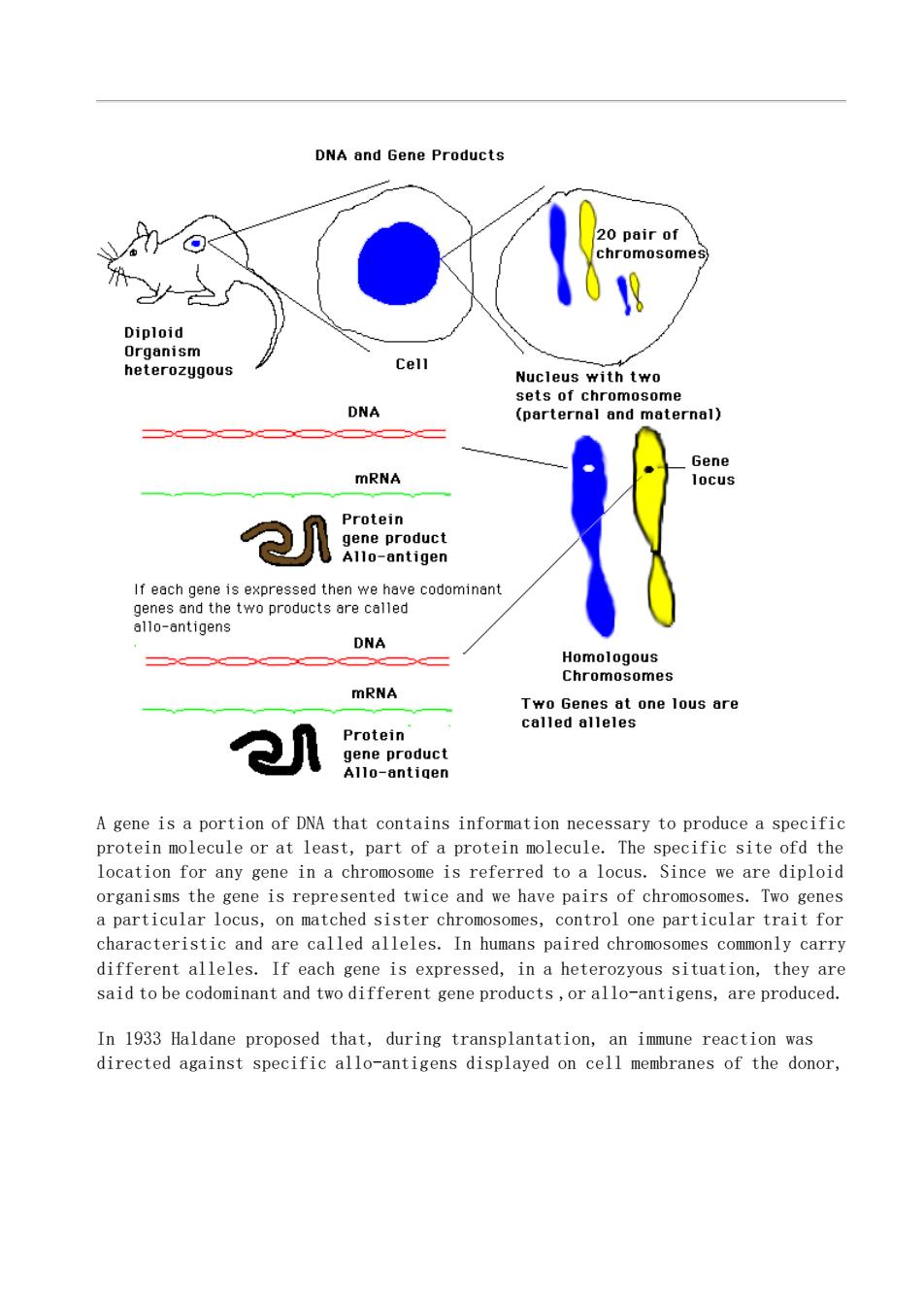
DNA and Gene Products o pair of Diploid hetersm Cell Nucleus with two DNA 8e98rnhr8m0erna mRNA 己八n Protein If each gene is expressed then we have codominant DNA Homologous Chromosomes mRNA Protein e-anusen A gene is a portion of DNA that contains information necessary to produce a specific eation t gnee I referred to a locus. part of a protein molecule.The specific site ofd the Since we are diploid organisms the gene is represented twice and we have pairs of chromosomes.Two genes a particular locus,on matched sister chromosomes,control one particular trait for characteristic and are called alleles.In humans paired chromosomes commonly carry different alleles.If each gene is expressed,in a heterozyous situation,they are said tobe codominant and are produced In 1933 Haldane proposed that,during transplantation,an immune reaction was directed against specific allo-antigens displayed on cell membranes of the donor
A gene is a portion of DNA that contains information necessary to produce a specific protein molecule or at least, part of a protein molecule. The specific site ofd the location for any gene in a chromosome is referred to a locus. Since we are diploid organisms the gene is represented twice and we have pairs of chromosomes. Two genes a particular locus, on matched sister chromosomes, control one particular trait for characteristic and are called alleles. In humans paired chromosomes commonly carry different alleles. If each gene is expressed, in a heterozyous situation, they are said to be codominant and two different gene products ,or allo-antigens, are produced. In 1933 Haldane proposed that, during transplantation, an immune reaction was directed against specific allo-antigens displayed on cell membranes of the donor
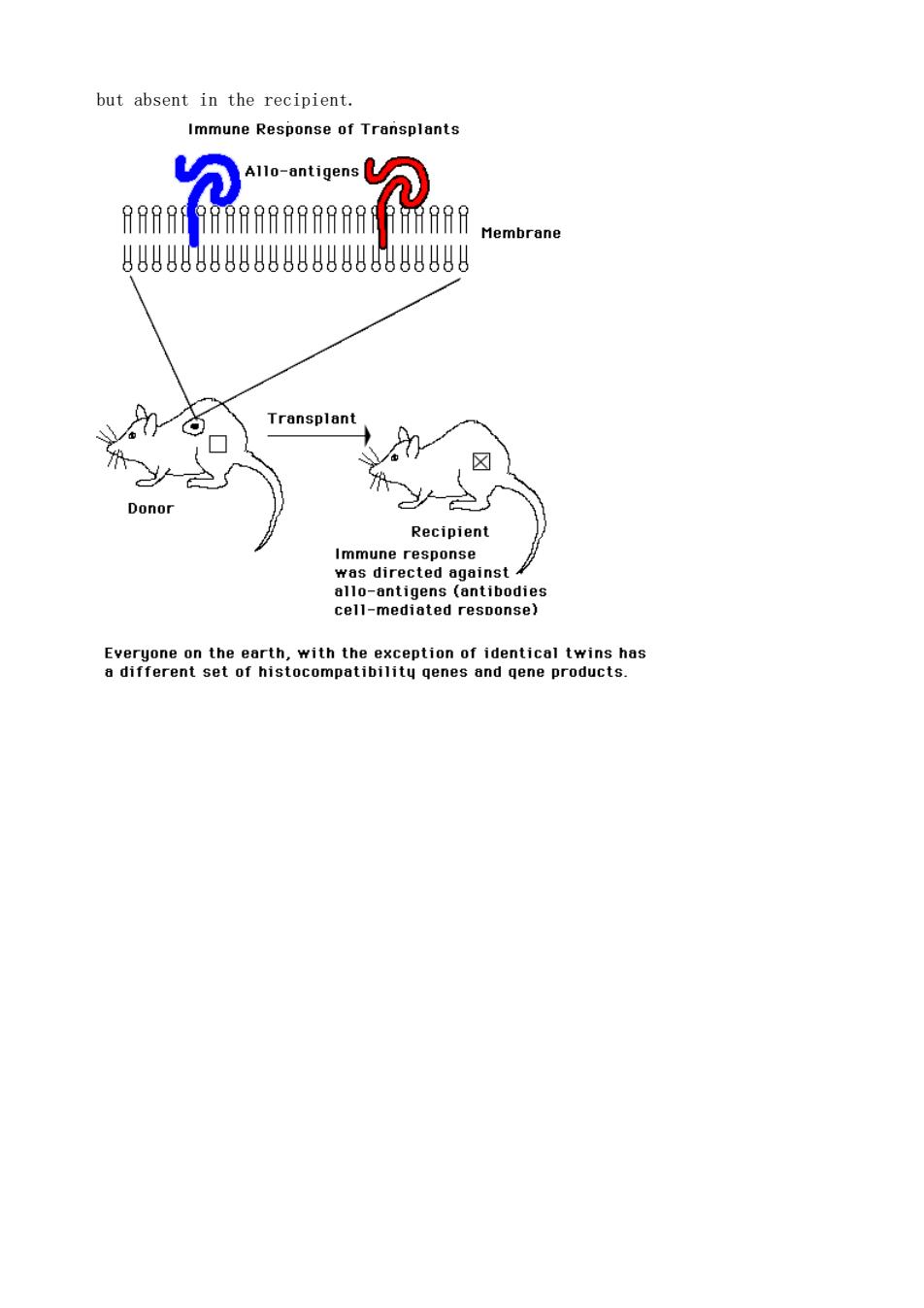
but absent in the recipient. Immune Response of Transplants HAAALHAAAHAAAAAHALAAAHAA Transplant ◇ ☒ Donor Recipient Immune response alo-antigens (antibodies cell-mediated response)
but absent in the recipient
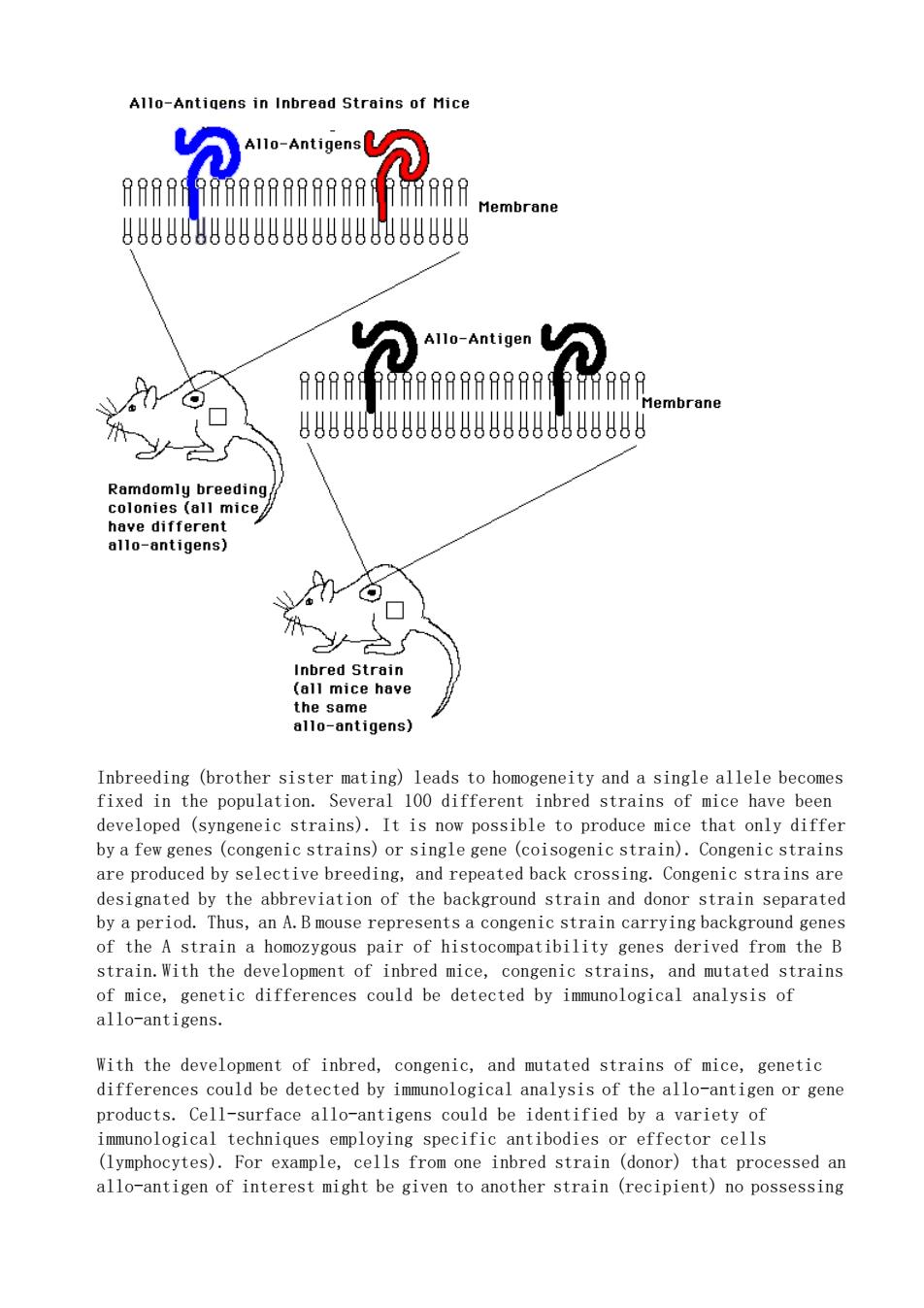
Allo-Antigens in Inbread Strains of Mice Al10-Antigens 888888888888888888888888 Allo-Antigen embrane 88886888888888888688888 Ramdomly breeding colonies(all mice allo-ontigens) Inbreeding (brother sister mating)leads to homogeneity and a single allele becomes fixed in the population.Several 100 different inbred strains of mice have been developed (syn are produced by selective breeding,and repeated back crossing.Congenic strains are designated by the abbreviation of the background strain and donor strain separated by a period.Thus,an A.B mouse represents a congenic strain carrying background genes of the A strain a homozygous pair of histocompatibility genes derived from the B strain.With the dev lopment of inbred mice,congenic strains. and mutated strains of mice,genetic differences could be detected by immunological analysis of allo-antigens. With the development of inbred,congenic,and mutated strains of mice,genetic differences could be detected by immunological analysis of the allo-antigen or gene products.Cell-surface allo-antigens could be identified by a variety of techniques employing specific antibodiesor effector ce (lymphocytes).For example,cells from one inbred strain (donor)that processed an allo-antigen of interest might be given to another strain (recipient)no possessing
Inbreeding (brother sister mating) leads to homogeneity and a single allele becomes fixed in the population. Several 100 different inbred strains of mice have been developed (syngeneic strains). It is now possible to produce mice that only differ by a few genes (congenic strains) or single gene (coisogenic strain). Congenic strains are produced by selective breeding, and repeated back crossing. Congenic strains are designated by the abbreviation of the background strain and donor strain separated by a period. Thus, an A.B mouse represents a congenic strain carrying background genes of the A strain a homozygous pair of histocompatibility genes derived from the B strain.With the development of inbred mice, congenic strains, and mutated strains of mice, genetic differences could be detected by immunological analysis of allo-antigens. With the development of inbred, congenic, and mutated strains of mice, genetic differences could be detected by immunological analysis of the allo-antigen or gene products. Cell-surface allo-antigens could be identified by a variety of immunological techniques employing specific antibodies or effector cells (lymphocytes). For example, cells from one inbred strain (donor) that processed an allo-antigen of interest might be given to another strain (recipient) no possessing
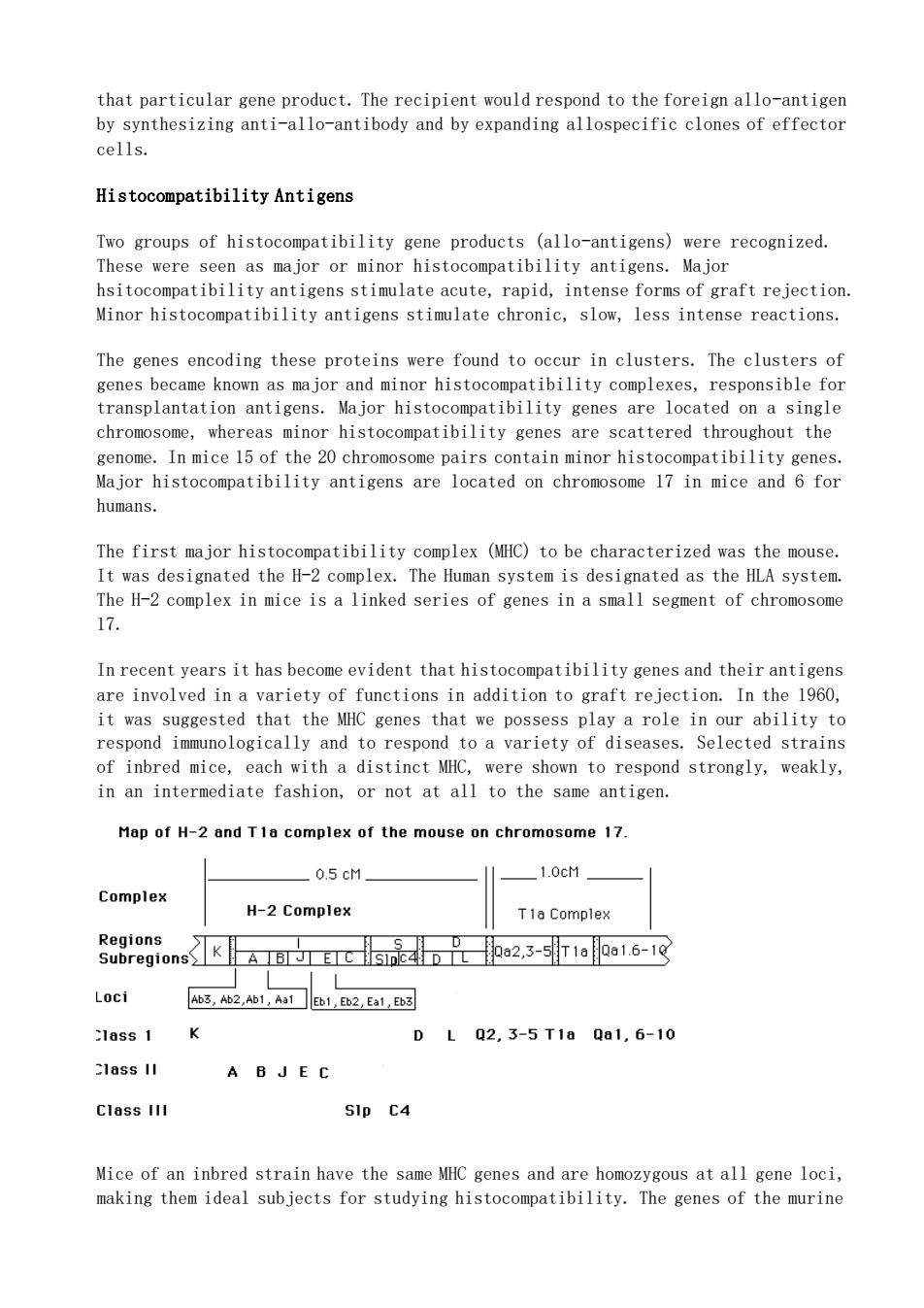
that particular gene product.The recipient would respond to the foreign allo-antigen by synthesizing anti-allo-antibody and by expanding allospecific clones of effector cells. Histocompatibility Antigens Two groups of histocompatibility gene products (allo-antigens)were recognized. These were seen as major or minor histocompatibility antigens.Major hsitocompatibility antigens stimulate acute,rapid,intense forms of graft rejection. Minor histocompatibility antigens stimulate chronic,slow,less intense reactions. encoding these proteins were found to occur in clusters.The clusters of asplantation antigens.jor histocompatibility genes are located on a ecam atibility complexes,responsible fo chromosome,whereas minor histocompatibility genes are scattered throughout the genome.In mice 15 of the 20 chromosome pairs contain minor histocompatibility genes. Major histocompatibility antigens are located on chromosome 17 in mice and 6 for humans The first major histocompatibility complex (MC)to be characterized was the mouse It was designated the H-2 complex.The Human system is designated as the HLA system The h-2 complex in mice is a linked series of genes in a small segment of chromosome 17. In recent years it has become evident that histocompatibility genes and their antigens are involved in a variety of functions in addition to graft rejection.In the 1960 it was suggested that the MHC genes that we possess play a role in our ability to respond immunologically and to respond to a variety of diseases.Selected strains of inbred mice,each with a distinct MHC,were shown to respond strongly,weakly, in an intermediate fashion,or not at all to the same antigen. Map of H-2 and T1a complex of the mouse on chromosome 17. 0.5cM Complex H-2 Complex Tia Complex Loci Ab3,A62,Ab1,As1☐E®1,Eb2,E61,Eb3 class 1 K DL02.3-5T1aQa1,6-10 class I Class Ill SIp C4 Mice of an inbred strain have the same MHC genes and are homozygous at all gene loci, making them ideal subjects for studying histocompatibility.The genes of the murine
that particular gene product. The recipient would respond to the foreign allo-antigen by synthesizing anti-allo-antibody and by expanding allospecific clones of effector cells. Histocompatibility Antigens Two groups of histocompatibility gene products (allo-antigens) were recognized. These were seen as major or minor histocompatibility antigens. Major hsitocompatibility antigens stimulate acute, rapid, intense forms of graft rejection. Minor histocompatibility antigens stimulate chronic, slow, less intense reactions. The genes encoding these proteins were found to occur in clusters. The clusters of genes became known as major and minor histocompatibility complexes, responsible for transplantation antigens. Major histocompatibility genes are located on a single chromosome, whereas minor histocompatibility genes are scattered throughout the genome. In mice 15 of the 20 chromosome pairs contain minor histocompatibility genes. Major histocompatibility antigens are located on chromosome 17 in mice and 6 for humans. The first major histocompatibility complex (MHC) to be characterized was the mouse. It was designated the H-2 complex. The Human system is designated as the HLA system. The H-2 complex in mice is a linked series of genes in a small segment of chromosome 17. In recent years it has become evident that histocompatibility genes and their antigens are involved in a variety of functions in addition to graft rejection. In the 1960, it was suggested that the MHC genes that we possess play a role in our ability to respond immunologically and to respond to a variety of diseases. Selected strains of inbred mice, each with a distinct MHC, were shown to respond strongly, weakly, in an intermediate fashion, or not at all to the same antigen. Mice of an inbred strain have the same MHC genes and are homozygous at all gene loci, making them ideal subjects for studying histocompatibility. The genes of the murine